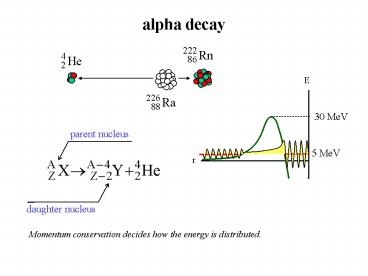alpha decay - PowerPoint PPT Presentation
1 / 13
Title:
alpha decay
Description:
The absorption of photons associated with photodisintegration occurs above precise energy thresholds causing removal of a nucleon from the nucleus 9Be + h ... – PowerPoint PPT presentation
Number of Views:206
Avg rating:3.0/5.0
Title: alpha decay
1
alpha decay
Momentum conservation decides how the energy is
distributed.
2
Decay Scheme of ?-emission
The nuclear reaction
Q? 4.869
0.600
?
0.414
0.26
5.4
0.186
0.3 ns
94.6
?
3
beta decay
Kmax
Energy spectrum and the conservation laws require
another particle to be emitted
4
Decay Scheme of ?-emission
The nuclear reaction
?-
equivalent to
Q? 2.49
6.6 ns
5
Decay Scheme of ?-emission
The nuclear reaction
?
equivalent to
0.51
3 ps
6
gamma decay
Very often the nucleus that undergoes radioactive
decay is left in an excited state. In secondary
decay the nucleus emits a high-energy photon.
e-
13.4 MeV
e-
4.4 MeV
7
electron capture
Parent nucleus captures one of its shell
electrons (K-electrons).
A neutrino is difficult to detect. Electron
capture is associated with x-ray emission caused
by electronic transitions.
8
Decay Scheme for Electron Capture
The nuclear reaction
equivalent to
EC
Q? 0.752
0.2 ns
9
Positron-Electron Annihilation
e e- 2h?
Usually annihilation takes place at low kinetic
energy of the particles.
Conservation of momentum requires the emission of
two (511 keV) photons emitted in the opposite
directions.
10
Pair Production
h? gt 1.02 MeV
Almost the entire energy of the photon is used
for the relativistic energy of the pair.
The recoil of the nucleus satisfies the momentum
conservation.
11
Photodisintegration
The absorption of photons associated with
photodisintegration occurs above precise energy
thresholds causing removal of a nucleon from the
nucleus
9Be h? ? 8Be 1n (1.66 MeV)
2H h? ? 1H 1n (2.22 MeV)
Photodisintegration is used for calibration.
1n
High energy photons (gt20MeV) used to produce
neutron beams..
12
Nuclear Fission
Neutron bombardment of heavy nuclei may cause
nuclear fission, in which a heavy nucleus is
split into lighter nuclei.
13
Fusion Reactions
When two light nuclei combine to form a heavier
nucleus, the process is called nuclear fusion.
proton cycle
In the cycle four protons are combined to form an
alpha particle and two positrons releasing 25 MeV
of energy
The reactions require high pressure and high
temperature.

